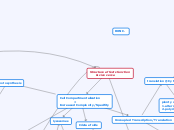Structure affects function
& vice versa
Cell Compartmentalization
=
Increased Complexity/Specifity
lysosomes
risky acidic pH environment
kept away from cell interior
Cristae folds
maximize
space for
# of ETC
per mitochondria
Uncoupled Transcription/Translation
translation @ Cytoplasm
plenty of space for
1. alternative splicing
2. polyribozymatic translation
All Genetic Information
is expressed/transferred in a Regulated Manner
prokaryotic regulation
prokaryotic operon
eukaryotic regulation
chromatin folding @ nucleus
transcription factor-control sequence
eukaryotic coordinated control
Parallels to
Cell Division
Mitotic division:
Result= diploid division
of somatic cells
Meiotic Division:
Result= haploid division
of germ cells
transcription @ Nucleus
Photosynthesis
Proteins
Mediate Function
movement
motor protein
microtubule
+
cytoplasmic dynein
=
lysosomal movement
to fuse w/ plasma mem
for exocytosis
kinetochore movement
kinetochore microtubule
+
motor protein
separation of chromatids
kinetochore microtubule
+
motor protein
separation of homologs & chromatids
Enzymes:
tertiary structure +
Active Site exposed R groups
Photosynthetic
Efficiency
PEP Carboxylase's
exclusive CO2 Affinity
minimizing photorespiration
Metalloenzyme Breaking H20
constant supply of e- to PSII
photosynthetic chemiosmosis
Stroma>Thylakoid space>Stroma
direction of ATP formation
ATP deposited where needed the most
by stroma occurring Calvin Cycle
Light harvesting complex
pigment molecules
positioned in a cluster maximize e-
energy release in order to truly excite P680/700
of reaction complex
Phostosystems are Integral Proteins!
Integrins facilitate ECM>cytoplasm contact
Positioning of primary e- acceptor
right next to highly energetic a pair e-
result: maximizing oxidative power
Allosteric?
One Active Subunit
activates ALL close proximity
subunit active sites
Enzyme becomes more specific
Protein-Protein Interactions
Recognition
Ligand- G Protein Coupled Receptor
Ligand- RTK Receptor
Ligand- Gated Ion Channel Receptor
Carrier/Channel Proteins
Signal Transduction Pathway
Possible transcription factor cellular response post Signal Transduction Pathway
Cyclin-CDK
Recognition
Allows for S phase to proceed
Regulates whether or not M
phase occurrs
Histone core
potentially prevents condensing
